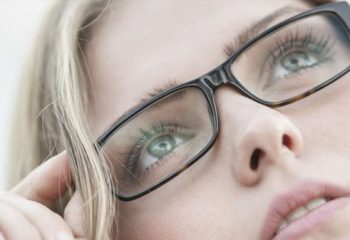One of the clearest signs that you might need glasses is the inability to read an actual sign. But there are many other clues that can reveal if your powers of observation are fading.
There’s no need for the Sherlock Holmes-style looking glass—eye vision problems are more common than you might think. Roughly 60 percent of the world’s population requires vision correction, according to the Vision Impact Institute.1 That’s a lot of people, but the good news is 80 percent of all visual impairment can be avoided or corrected.2
The key to understanding the clues is fortunately not a mystery. It simply takes understanding the symptoms, said Dr. John Lahr, divisional vice president of EyeMed Provider Relations and medical director.
“Symptoms of vision impairment are wide ranging,” Dr. Lahr said. “However, the only way to accurately diagnose a vision problem is to see an eye care professional.”
The 10 signs
Wondering if you need eyeglasses? Dr. Lahr suggests the following 10 signs may signal it’s time to schedule an eye exam:
| 1. | Blurred vision: If you no longer recognize a friend 10 steps away, or your favorite magazine has become too fuzzy to read up close, you may be developing farsightedness or nearsightedness. If you find it difficult to see objects both near and far, that may be astigmatism, a common condition involving a curvature of the eye lens or cornea.3 |
| 2. | Difficulty seeing at night: If your night vision is fading so you no longer can see your dog in the yard or the newspaper on the early morning walkway, you may be experiencing signs of early cataracts, which should be examined as soon as possible.4 |
| 3. | Troubles adjusting from dark to light: If it takes your eyes longer to adjust after seeing bright lights on the highway, it likely means the muscles that help your iris contract and expand are weakening. It’s likely due to age, as are many vision problems.5 |
| 4. | Difficulty at the computer: You can try to blame it on work, but oftentimes those who struggle to read the computer after a time may be experiencing a clue to farsightedness. Start each day with the same page and sit at a measured distance to see if your vision worsens. |
| 5. | Eye strain or fatigue: Do 20 minutes of reading wear your eyes out like 1 hour did a year ago? Eye fatigue results from blurry vision or when you regularly squint or blink to bring items into focus, but it also can occur from driving, writing or mobile phone addiction. Try taking regular breaks or change the lighting to reduce glare. If the fatigue persists, see your doctor.6 |
| 6. | Frequent headaches: Sometimes the mechanism that helps the cornea and lens focus on images fails, and the small muscles in the eye are forced to work harder. The result is eye strain, which can lead to headaches.7 Put in simple terms: When you squint, it can cause headaches, and you may need glasses. |
| 7. | Double vision: Drinking jokes aside, double vision can lead to serious issues. Seeing double may indicate problems with your cornea or eye muscles. It can also be a symptom of cataracts. Call the doctor on the double.8 |
| 8. | Wavy vision: Do the blinds covering the kitchen window suddenly look like they are under water? When straight lines appear distorted, or colors look faded, it may be a sign of macular degeneration, the deterioration of the central portion of the retina and a leading cause of vision loss.9 |
| 9. | Seeing halos: if you see halos around objects, and you are not in church, it may signal developing cataracts or night vision problems. These halos are usually more pronounced in the dark and surround objects.9 |
| 10. | Eye pressure: If you feel pressure behind the eye, it may be a sign of developing glaucoma. No need to panic, though, because it’s highly treatable. Pressure buildup can damage the optic nerve that transmits images to your brain, but not everyone who experiences eye pressure has glaucoma. Still, you should get it checked.9 |
While the presence of one or more of these symptoms doesn’t mean a guaranteed vision problem, an eye exam is recommended as a precaution. It is essential to have a qualified eye doctor examine your eyes to understand what’s causing these changes. It’s the only true way to find out if you need glasses, and to improve your power of observation.
____________________________________________________
1. “The Cost of Uncorrected Vision,” Jean-Félix Biosse-Duplan, The Vision Impact Institute, Oct. 24, 2014
2. “Visual impairment and blindness,” World Health Organization, August 2014, http://www.who.int/mediacentre/factsheets/fs282/en/
3. Diseases and Conditions, Astigmatism, Mayo Clinic, http://www.mayoclinic.org/diseases-conditions/astigmatism/basics/definition/con-20022003
4. “Night Vision Problems: Halos, Blurred Vision, and Night Blindness,” WebMD, http://www.webmd.com/eye-health/night-vision-problems-halos-blurred-vision-night-blindness
5. “Growing Older and Adjusting to the Dark,” by Jane Brody, The New York Times, March 13, 2007
6. “Eye Fatigue,” WebMD, http://www.webmd.com/eye-health/eye-fatigue-causes-symptoms-treatment#2
7. “Headache and eye problems,” Better Health Channel, http://www.betterhealth.vic.gov.au/bhcv2/bhcarticles.nsf/pages/Headache_and_eye_problemshttp://www.betterhealth.vic.gov.au/bhcv2/bhcarticles.nsf/pages/Headache_and_eye_problems
8. “Double Vision (Diplopia),” WebMD, http://www.webmd.com/eye-health/double-vision-diplopia-causes-symptoms-diagnosis-treatment
9. “Vision Problems,” U.S. National Library of Medicine, https://www.nlm.nih.gov/medlineplus/ency/article/003029.htm
Source: www.eyesiteonwellness.com







